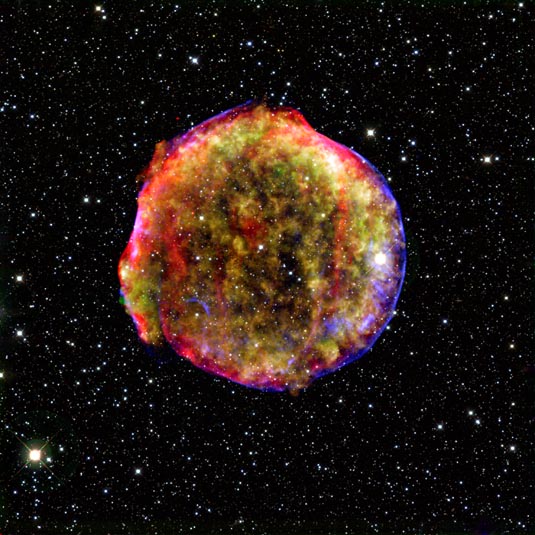
Description: Supernova Remnant
Position (J2000): RA: 00h 25m 9.0s Dec: 64° 9' 55.0"
Constellation: Cassiopeia
Observation Date: Apr 29, 2003
Observation Time: 41 hours
Instrument: ACIS
Distance Estimate: 13,000 light years
Scale: Image is 15.5 arcmin across.
Image Credit: X-ray: NASA/CXC/SAO, Infrared: NASA/JPL-Caltech,
Optical: MPIA, Calar Alto, O.Krause et al.
Release Date: February 18, 2009
ABOUT THIS IMAGE:
This composite image
of the Tycho supernova remnant combines infrared and X-ray observations
obtained with NASA's
Spitzer and Chandra space observatories, respectively, and the Calar Alto
observatory, Spain. It shows the scene more
than four centuries after the brilliant star explosion witnessed by Tycho
Brahe and other astronomers of that era.
The explosion has
left a blazing hot cloud of expanding debris (green and yellow). The location
of the blast's outer shock
wave can be seen as a blue sphere of ultra-energetic electrons. Newly
synthesized dust in the ejected material and heated
pre-existing dust from the area around the supernova radiate at infrared
wavelengths of 24 microns (red). Foreground and
background stars in the image are white.
Oliver Krause, from the Max Planck Institute for Astronomy in Germany,
recently studied reflected light from the supernova explosion seen by
Brahe. Use of these "light echoes" - not shown in this figure
- has confirmed previous suspicions that the explosion was a Type Ia supernova.
This type of supernova is generally believed to be caused by the explosion
of a white dwarf star in a binary star system.
Color Code: X-ray: Yellow, Green, Blue Infrared: Red Optical: White stars